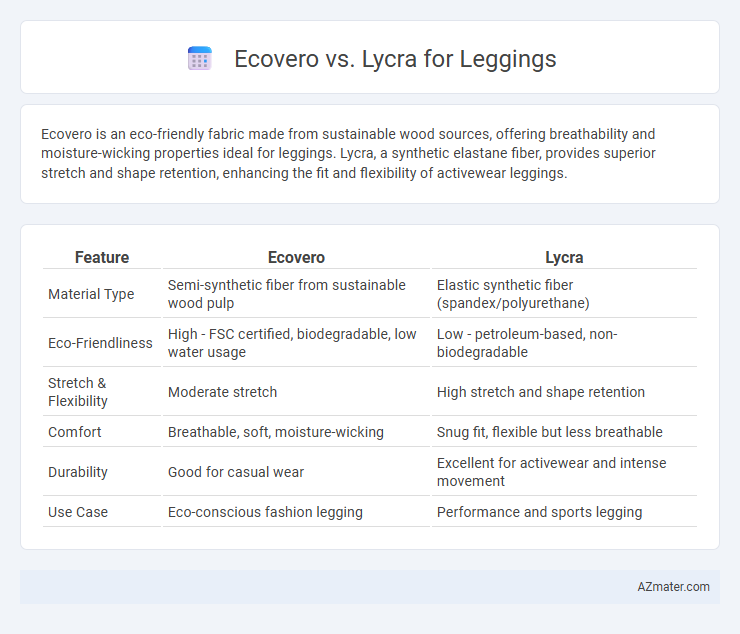Ecovero is an eco-friendly fabric made from sustainable wood sources, offering breathability and moisture-wicking properties ideal for leggings. Lycra, a synthetic elastane fiber, provides superior stretch and shape retention, enhancing the fit and flexibility of activewear leggings.
Table of Comparison
| Feature | Ecovero | Lycra |
|---|---|---|
| Material Type | Semi-synthetic fiber from sustainable wood pulp | Elastic synthetic fiber (spandex/polyurethane) |
| Eco-Friendliness | High - FSC certified, biodegradable, low water usage | Low - petroleum-based, non-biodegradable |
| Stretch & Flexibility | Moderate stretch | High stretch and shape retention |
| Comfort | Breathable, soft, moisture-wicking | Snug fit, flexible but less breathable |
| Durability | Good for casual wear | Excellent for activewear and intense movement |
| Use Case | Eco-conscious fashion legging | Performance and sports legging |
Introduction to Ecovero and Lycra
Ecovero is a sustainable fabric made from certified wood pulp, known for its eco-friendly production process and biodegradability, making it an ideal choice for environmentally conscious legging designs. Lycra, a synthetic elastane fiber, is renowned for its exceptional stretch, shape retention, and comfort, providing leggings with superior flexibility and durability. Both materials offer distinct benefits, with Ecovero focusing on sustainability and Lycra emphasizing performance and fit in activewear.
Fabric Origins and Sustainability
Ecovero is a sustainable fabric derived from certified renewable wood sources through a closed-loop production process that significantly reduces water consumption and carbon emissions, making it an eco-friendly choice for leggings. Lycra, a synthetic fiber made from petrochemicals, offers exceptional stretch and durability but relies on non-renewable fossil fuels and is less biodegradable, raising concerns regarding its environmental impact. Selecting Ecovero leggings supports sustainable forestry and low-impact manufacturing, whereas Lycra focuses primarily on performance and elasticity with a higher ecological footprint.
Comfort and Wearability
Ecovero fabric offers superior breathability and moisture management, enhancing comfort during extended wear in leggings. Lycra provides exceptional elasticity and shape retention, ensuring leggings maintain a snug fit without compromising mobility. Combining Ecovero's eco-friendly softness with Lycra's stretchability results in leggings that deliver both comfort and durable wearability.
Stretch and Fit Performance
Ecovero leggings offer excellent moisture management and breathability but generally have less stretch and shape retention than Lycra-based fabrics. Lycra fibers provide superior elasticity and recovery, ensuring leggings fit snugly and move comfortably with the body during intense activities. For optimal stretch and fit performance, Lycra remains the preferred choice in activewear, while Ecovero balances sustainability with moderate flexibility.
Breathability and Moisture Management
Ecovero fabric, made from sustainably sourced wood pulp, offers excellent breathability and moisture management due to its natural cellulose fibers that wick sweat away efficiently, keeping the skin dry and comfortable during workouts. Lycra, a synthetic elastane fiber, provides superior stretch and shape retention but tends to trap heat and moisture, which can reduce breathability and increase sweating in high-intensity activities. Choosing Ecovero-based leggings enhances airflow and moisture control, making them ideal for extended wear or low-impact exercises, whereas Lycra excels in support and flexibility for dynamic movements.
Durability and Longevity
Ecovero fabric, made from sustainable viscose fibers, offers moderate durability with soft texture, making it ideal for eco-friendly leggings but less resistant to wear and tear compared to Lycra. Lycra, a high-performance synthetic elastane, excels in stretch retention and durability, ensuring leggings maintain shape and withstand frequent use over time. For longevity and durability in activewear leggings, Lycra-infused fabrics outperform Ecovero blends due to superior elasticity and resistance to abrasion.
Environmental Impact Comparison
Ecovero, made from sustainably sourced wood pulp, offers significant environmental benefits with a 50% reduction in greenhouse gas emissions and water usage compared to conventional viscose, making it a more eco-friendly choice for leggings. Lycra, a synthetic fiber derived from non-renewable petroleum, has a higher environmental footprint due to energy-intensive production and non-biodegradability. Choosing leggings with Ecovero supports lower carbon emissions and reduced resource consumption, aligning with sustainable fashion goals.
Care Instructions and Maintenance
Ecovero leggings require gentle washing in cold water to preserve their sustainable viscose fibers, avoiding bleach and tumble drying to maintain fabric integrity. Lycra leggings benefit from machine washing in cold water with similar precautions but should be air-dried to retain elasticity and prevent fiber breakdown. Both fabrics perform best when washed inside out with mild detergents, ensuring durability and prolonged wear.
Cost and Market Availability
Ecovero leggings tend to have a higher production cost due to their sustainable viscose fibers sourced from certified renewable wood, making them pricier compared to Lycra leggings, which are generally more cost-effective due to mass production of synthetic elastane. Market availability of Ecovero leggings is more limited, primarily found in eco-conscious brands and niche sustainable fashion retailers, whereas Lycra leggings dominate mainstream activewear markets and are widely available in sporting goods stores and online platforms. The price difference and distribution channels reflect the distinct consumer segments targeting eco-friendly versus performance and affordability priorities.
Final Verdict: Best Fabric for Leggings
Ecovero and Lycra serve distinct purposes in legging fabrics, with Ecovero being a sustainable, eco-friendly viscose that offers breathability and softness, while Lycra provides exceptional stretch, shape retention, and durability. For leggings requiring superior elasticity and a snug fit, Lycra is the best fabric, ensuring comfort during high-movement activities like running or yoga. Ecovero is ideal for those prioritizing sustainability and moisture-wicking properties but lacks Lycra's stretch performance, making Lycra the preferred choice for performance leggings.

Infographic: Ecovero vs Lycra for Legging
 azmater.com
azmater.com